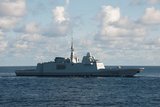General Dynamics’ PRC-155 Manpack radio demonstrates capabilities
General Dynamics C4 Systems’ AN/PRC-155 Manpack radio has successfully completed a secure radio-to-radio voice and data communications test through the Mobile User Objective System (MUOS) satellite network. This is the first time that a military radio has communicated with the MUOS space-ground network, which will ultimately extend the reach of the soldiers' network to even the most isolated locations.
The test, part of a scheduled MUOS end-to-end system test, saw an AN/PRC-155 radio transmit voice and data communications to the orbiting MUOS satellite, through the MUOS ground station and back to a second PRC-155 Manpack radio. The test was conducted using the final version of the MUOS waveform.
The PRC-155 Manpack radios also demonstrated the capability that allows soldiers to network their communications using the MUOS system, connecting them to one another wherever they are deployed, on foot, from land vehicles, ships, submarines and aircraft. The radios used during the test were among the first delivered to the US Army under a contract to produce more than 3,800 PRC-155 Manpack radios.
The General Dynamics-developed, non-proprietary MUOS waveform used for the test delivers high-speed voice and data communications at 16-times greater capacity than the military's current Ultra High Frequency (UHF) satellite communications system.
Chris Marzilli, president of General Dynamics C4 Systems, said: ‘The PRC-155 is the only government-owned, off-the-shelf radio to demonstrate this capability. Using the same cell phone technology that powers commercial smartphones, military and government personnel can make secure 'calls' and exchange critical information from anywhere in the world.’
The PRC-155 radio is part of the Handheld, Manpack, Small Form Fit (HMS) family of radios. The radio also runs the essential waveforms from the Joint Tactical Networking Center library. They include the Soldier Radio Waveform (SRW), which connects dismounted soldiers to the network, and the Wideband Networking Waveform (WNW), which seamlessly transports large amounts of data and the legacy SINCGARS waveform for communication with existing radios. Using the PRC-155's two-channel capability, soldiers operating on any of these waveforms on one channel, can interconnect with soldiers using another waveform on the second channel.
More from Digital Battlespace
-
![Babcock nears first customer for Nomad AI translation tool]()
Babcock nears first customer for Nomad AI translation tool
Nomad can provide militaries with real-time intelligence, saving critical time on the battlefield.
-
![AUSA 2025: Israel’s Asio Technologies to supply hundreds of improved Taurus tactical systems]()
AUSA 2025: Israel’s Asio Technologies to supply hundreds of improved Taurus tactical systems
Taurus operates alongside the Israel Defense Forces’ Orion system which supports mission management across tens of thousands of manoeuvring forces, from squad leaders to battalion commanders.
-
![AUSA 2025: Kopin pushes micro-LED plans as China moves faster]()
AUSA 2025: Kopin pushes micro-LED plans as China moves faster
The plan for the new displays follows fresh investment in Kopin’s European facilities by Theon and an order for head-up displays in fielded aircraft, with funding from the US Department of Defense.
-
![AUSA 2025: Persistent Systems to complete its largest order by year’s end]()
AUSA 2025: Persistent Systems to complete its largest order by year’s end
Persistent Systems received its largest ever single order for its MPU5 devices and other systems earlier this month and has already delivered the 50 units to the US Army’s 4th Infantry Division.
-
![Aselsan brings in dozens of companies and systems under the Steel Dome umbrella]()
Aselsan brings in dozens of companies and systems under the Steel Dome umbrella
Turkey has joined the family of countries attempting to establish a multilayered air defence system with government approval in August 2024 for the effort landed by Aselsan. Dubbed Steel Dome, the programme joins Israel’s Iron Dome, the US Golden Dome, India’s Mission Sudarshan Chakra and South Korea’s low-altitude missile defence system.
-
![DSEI 2025: MARSS unveils new agnostic multidomain C4 system]()
DSEI 2025: MARSS unveils new agnostic multidomain C4 system
MARSS’ NiDAR system has been deployed using sensors from static platforms to provide detection and protection for static sights, such as critical infrastructure, ports and military bases.




























